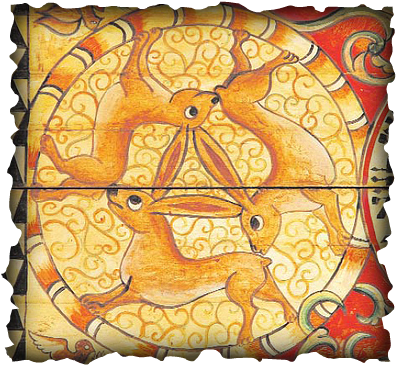Making the rounds of the internet, YouTube and Facebook is an oddball new dance being done by Chassidic men. It’s done in the traditional file formation, called a honga, but what are those steps they’re doing? Is it? No, it can’t be. Oh yes, it is. It’s the Bunny Hop
The bunny hop dance evidently came out of Balboa High School in San Francisco around 1952. According to a TIME magazine article from 1953 the dance came first, followed by the eponymous tune, written and recorded by Ray Anthony as an instruction song also in 1952:
Put your right foot forward
Put your left foot out
Do the Bunny Hop
Hop, hop, hop,
Etc., and again as an instrumental in 1958.
Yes, that party standard from the youth of the boomer generation has reared it bunny ears and fluffy tail again, to a recent Moldovan tune and as a Moldovan wedding dance, having undergone a species change. The Bunny Hop is now the Penguin Dance. The number of videos of this dance phenomenon, and the obscure places around the world (including Saudi Arabia!) where it is springing up are multiplying like, well, you know.
A couple of observations about the way Chassidic men dance it. First, they eschew the more typical, and intimate, not to say ticklish, waist hold, for the shoulder hold typical of a Chassidic men’s honga. Second, Jill Gellerman, who has done wonderful research into Chassidic wedding dances, especially among women, has noted that bunny hop type steps have long ago infiltrated the women’s simcha dance repertoire. Chassidic men, though, don’t tend to go for choreographed, so this is an interesting exception. And finally, at about 1:10 in the video you can hear someone, probably the musician, say “Ma Zel Tov!” on the three hops. I suspect that to traditional Jewish ears, most any short-short-long rhythmic figure in music sounds like “mazel tov!”.
Whatever made this dance catch on globally, even in the Chassidic community? It’s a thing, but is it a good thing? It’s certainly novel (in the Chassidic context) but it is chiefly low cost, in terms of effort required to learn it. It’s just so darn easy. I think that explains a lot. For instance, there is a Finnish dance called Jenkka that is the local version of the popular 19th century dance, the Schottish. That dance takes some practice with a partner, so in this video you can see how the unschooled can dance to the same music in a familiar looking letkajennkka long line.
For religious Jewish men, virtuosity in dance is not highly valued; one should be studying with that time and energy. We are not all religious Jewish men, though, and I think there is a place for virtuosity in Jewish dance, or at least the sense of there being some acquired skill involved. Accessible is good as an introduction, but I fear for a culture that is only always easily accessible.
This, standing on one foot, is my problem with the Penguin Dance Honga.
The bunny hop dance evidently came out of Balboa High School in San Francisco around 1952. According to a TIME magazine article from 1953 the dance came first, followed by the eponymous tune, written and recorded by Ray Anthony as an instruction song also in 1952:
Put your right foot forward
Put your left foot out
Do the Bunny Hop
Hop, hop, hop,
Etc., and again as an instrumental in 1958.
Yes, that party standard from the youth of the boomer generation has reared it bunny ears and fluffy tail again, to a recent Moldovan tune and as a Moldovan wedding dance, having undergone a species change. The Bunny Hop is now the Penguin Dance. The number of videos of this dance phenomenon, and the obscure places around the world (including Saudi Arabia!) where it is springing up are multiplying like, well, you know.
A couple of observations about the way Chassidic men dance it. First, they eschew the more typical, and intimate, not to say ticklish, waist hold, for the shoulder hold typical of a Chassidic men’s honga. Second, Jill Gellerman, who has done wonderful research into Chassidic wedding dances, especially among women, has noted that bunny hop type steps have long ago infiltrated the women’s simcha dance repertoire. Chassidic men, though, don’t tend to go for choreographed, so this is an interesting exception. And finally, at about 1:10 in the video you can hear someone, probably the musician, say “Ma Zel Tov!” on the three hops. I suspect that to traditional Jewish ears, most any short-short-long rhythmic figure in music sounds like “mazel tov!”.
Whatever made this dance catch on globally, even in the Chassidic community? It’s a thing, but is it a good thing? It’s certainly novel (in the Chassidic context) but it is chiefly low cost, in terms of effort required to learn it. It’s just so darn easy. I think that explains a lot. For instance, there is a Finnish dance called Jenkka that is the local version of the popular 19th century dance, the Schottish. That dance takes some practice with a partner, so in this video you can see how the unschooled can dance to the same music in a familiar looking letkajennkka long line.
For religious Jewish men, virtuosity in dance is not highly valued; one should be studying with that time and energy. We are not all religious Jewish men, though, and I think there is a place for virtuosity in Jewish dance, or at least the sense of there being some acquired skill involved. Accessible is good as an introduction, but I fear for a culture that is only always easily accessible.
This, standing on one foot, is my problem with the Penguin Dance Honga.

 RSS Feed
RSS Feed
